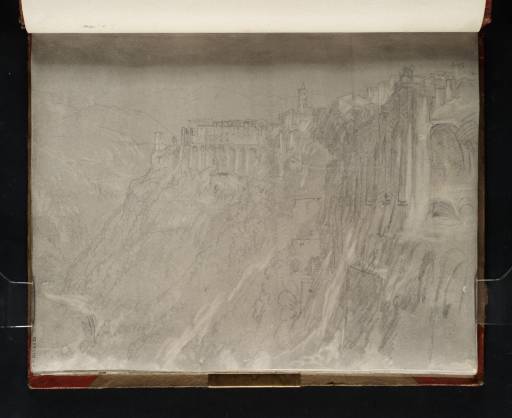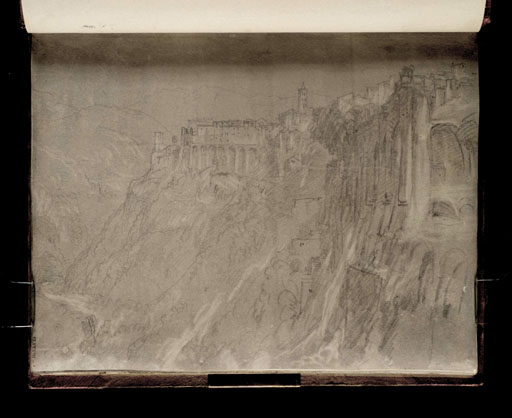Joseph Mallord William Turner View of Tivoli, from the Santuario di Ercole Vincitore 1819
Image 1 of 2
Joseph Mallord William Turner,
View of Tivoli, from the Santuario di Ercole Vincitore
1819
Joseph Mallord William Turner 1775–1851
Folio 6 Recto:
View of Tivoli, from the Santuario di Ercole Vincitore 1819
D15472
Turner Bequest CLXXXIII 6
Turner Bequest CLXXXIII 6
Pencil and grey watercolour wash on white wove paper, 200 x 253 mm
Stamped in black ‘CLXXXIII 6’ bottom left, descending left-hand edge
Stamped in black ‘CLXXXIII 6’ bottom left, descending left-hand edge
Accepted by the nation as part of the Turner Bequest 1856
Exhibition history
1878
[Oxford Loan Collection], University of Oxford, 1878–1916 (113 and 78b).
References
1878
Catalogue of Sketches by Turner Lent by The Trustees of the National Gallery to the Ruskin Drawing School, Oxford, London 1878, nos.113 (1st edition), 78b (2nd edition), as ‘Tivoli: Arcades and waters’.
1904
E.T. Cook and Alexander Wedderburn (eds.), Library Edition: The Works of John Ruskin: Volume XIII: Turner: The Harbours of England; Catalogues and Notes, London 1904, no.78, p.563, as ‘Tivoli. Arcades and waters’.
1909
A.J. Finberg, A Complete Inventory of the Drawings of the Turner Bequest, London 1909, vol.I, p.540, as ‘Arcades and Waters. (Oxford, 113–78b)’.
1914
Thomas Ashby, ‘Turner at Tivoli’, Burlington Magazine, vol.25, no.136, July 1914, p.247, reproduced pl.II, D [erroneously listed as pl.II, C], as ‘View from the Left Bank of the River. The Campanile of the Duomo in the Distance’.
1925
Thomas Ashby, Turner’s Visions of Rome, London and New York 1925, p.31, reproduced pl.27, as ‘Arcades and waters’.
1984
Cecilia Powell, ‘Turner on Classic Ground: His Visits to Central and Southern Italy and Related Paintings and Drawings’, unpublished Ph.D thesis, Courtauld Institute of Art, University of London 1984, p.174 note 19, reproduced pl.102, as ‘Tivoli’.
1987
Cecilia Powell, Turner in the South: Rome, Naples, Florence, New Haven and London 1987, p.[77] note 17, reproduced pl.78, as ‘Tivoli’.
Turner’s exploration of Tivoli included a large number of landscape sketches drawn from the valley to the north. He was particularly attracted by the spectacle of the town’s ancient ruins perched above the steep, wooded gorge and streaming cascatelli (or cascatelle), the lesser cascades of the River Aniene. The subject of this drawing is a view of Tivoli looking east from the arcades of the Santuario di Ercole Vincitore (Sanctuary of Hercules Victor), a first-century BC Roman temple dedicated to the cult of Hercules, formerly known as the Villa of Maecenas. As Thomas Ashby identified, the substructures visible in the central middle distance are those which support the Piazza dell’Olmo (present-day Piazza Domenico Tani), whilst to the right is the campanile of the Cathedral (Duomo) of San Lorenzo.1 At the left-hand tip of the edge of the slopes is a medieval watch-tower which stands above the valley, and the winding course of the river. A similar view can be found on folio 32 (D15499), and in the Tivoli and Rome sketchbook (D15039; Turner Bequest CLXXIX 60a). Like many drawings within this sketchbook, the composition has been executed over a washed grey background. Turner has created highlights within the work by rubbing or lifting out the wash to reveal the white paper beneath, principally to delineate the architecture and to depict the silvery streams of the falling water beneath the substructures of the temple. He has further enhanced the dramatic tonal contrasts by darkening the arched passageway on the right with vigorous shading and hatched lines.
The Santuario di Ercole Vincitore was one of Tivoli’s most famous landmarks and the picturesque qualities of the ruined arcades lying across the brow of the ravine had made it a popular subject for artists. This prospect of the arched gallery is reminiscent of a painting by the eighteenth-century Welsh landscape artist, Richard Wilson (1713–1782), Maecenas’s Villa, Tivoli circa 1765 (see Tate, N00303) which may have been known to Turner. A similar version of the same subject was owned by Joseph Farington (1747–1821), and later by John Constable (1776–1837).2 Further studies of the arcades beneath the Santuario can be seen on folios 9–10 and 20 (D15475–D15476 and D15486). For a fuller description and other sketches of the Santuario di Ercole Vincitore see folio 5 (D15471).
Verso:
Blank, except for traces of grey watercolour wash
Inscribed by ?John Ruskin in red ink ‘349’ bottom left, and by an unknown hand in pencil ‘76’ centre
Blank, except for traces of grey watercolour wash
Inscribed by ?John Ruskin in red ink ‘349’ bottom left, and by an unknown hand in pencil ‘76’ centre
Nicola Moorby
February 2010
How to cite
Nicola Moorby, ‘View of Tivoli, from the Santuario di Ercole Vincitore 1819 by Joseph Mallord William Turner’, catalogue entry, February 2010, in David Blayney Brown (ed.), J.M.W. Turner: Sketchbooks, Drawings and Watercolours, Tate Research Publication, December 2012, https://www


